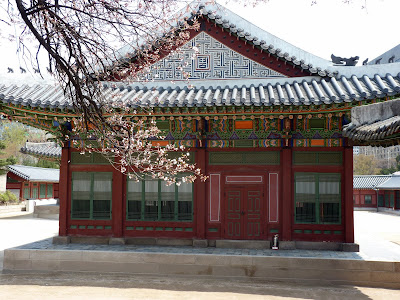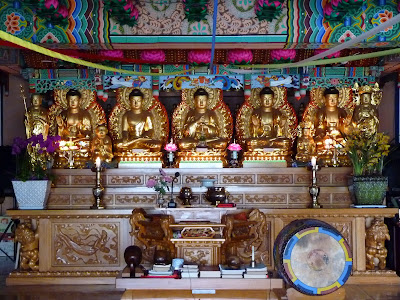 |
| Riding the metro in Seoul |
With well over twenty million inhabitants, Seoul is the world's second largest metropolitan area (after Tokyo and ahead of Mexico City) and a leading global economic center. Having resuscitated itself from rubble after the widespread destruction wrought by the Korean War, the city is now on a course to reinvent itself again. As our Lonely Planet guidebook describes it, the city has set out to "reshape itself from a hardened concrete and steel economic powerhouse into a softer-edged 21st-century urban ideal of parks, culture and design." Such a dramatic transformation may seem like just another politician's promise, but there are tangible signs that the plan is bearing fruit.
 |
| Typical scene at a royal palace in Seoul |
As part of Seoul's ambitious urban renewal effort, major restoration work has taken place - and is ongoing - at the largest of the city's Five Grand Palaces. The palaces were built by the kings of the Joseon Dynasty, which ruled Korea for five centuries, from about 1400-1900. Apart from their grand imperial architecture, the palaces and their expansive grounds serve as invaluable urban open space, providing leafy refuges from the noise and traffic of the city. The palaces have been destroyed (mainly by the Japanese) and rebuilt many times over the years, and only a portion of the original number of buildings are now standing. But that doesn't detract from the strong sense of harmony and history that the palaces exude.
 |
| Bukchon Hanok Village |
Historic architecture on a more modest scale can be found in an area known as Bukchon Hanok Village, which is clustered between the two largest royal palaces. Long ago, this is where the Korean aristocracy lived. This charming neighborhood now boasts hundreds of beautifully restored "hanok" (traditional Korean houses) that date back six centuries. It's a great place to wander the quiet streets and soak up the atmosphere. Walking from one royal palace to another past all the old wooden houses, it's hard to believe you're actually in a major metropolis.
 |
| Cheonggyecheon during the day |
Another worthwhile tourist attraction is the Cheonggyecheon, a small pretty stream that runs right through the heart of modern Seoul. In the surge of development in Seoul that followed the Korean War, the stream was utterly neglected - it was covered with concrete to build a freeway and it ultimately dried up. But in 2003, the mayor of Seoul embarked on a massive project that involved tearing down the freeway and pumping in water from the nearby Han River to restore the stream. This highly successful project was part of the larger municipal effort, alluded to above, to reintroduce nature into the city and promote a more eco-friendly urban design. Like the royal palaces, the restored stream provides an important open public space - especially for strollers, joggers, workers on their lunch break, young couples holding hands, and nine-year old boys who enjoy crossing bodies of water on a bridge of rocks. Jeremy and I thoroughly enjoyed walking along the Cheonggyecheon during the sun of day and again at night when the walkway along the stream is dramatically lit.
 |
| The Kwangchang Night Market |
For eating and drinking after a long day of sightseeing, Seoul offers a host of enticing options. My personal favorite was the Insadong neighborhood near our hotel, with its countless bars, restaurants, and narrow alleys filled with the smell of barbecued beef. For the center of such a large city, it's much more low-built than what I expected and there's actually a good bit of charm. It's a mostly pedestrian area with a variety of modern and post-modern architectural styles and a few traditional hanok thrown in as well. It was great fun to hook up with my law school friend Sam (who now lives in Seoul) for a few beers at a bar in Insadong whose facade was festooned with a giant plastic beer mug. (Wish I'd taken a picture of that!) Sam also took us to a couple of other trendy neighborhoods for some awesome barbecue and cold kimchee soup. One night when we were on our own, Jeremy and I trolled the Kwangchang Night Market for some sashimi, where we quickly made friends with the patrons sitting next to us. We also visited the Namdaemun Market by day, which was packed with shoppers, vendors of all sorts of goods (we bought many packs of seaweed, which Jeremy loves), and hole-in-the-wall eateries.
I know Seoul isn't on everyone's travel wish list, but it's a really fun place to visit and there are plenty of interesting things to do. You could spend a few days wandering through the royal palaces and street markets, and the distinctive, fiery cuisine is an attraction in and of itself. Jeremy still talks about the barbecued beef, the thick juicy noodles and some of the best seaweed in the world!
 |
| Jeremy has some fun at the National Folk Museum |
 |
| At one of the royal palaces |
 |
| Walking along the Cheonggyecheon |
 |
| At the Namdaemun Market |
 |
| At the Kwangchang Night Market |
 |
| Making friends over sashimi and soju (and soda for Jeremy) |
 |
| Walking back to our hotel from the Night Market |
 |
| Walking along the Cheonggyecheon again |
 |
| Bukchon Hanok Village |
 |
| Some more royal palace shots |
 |
| Posing for a picture (not for me) |

































































No comments:
Post a Comment